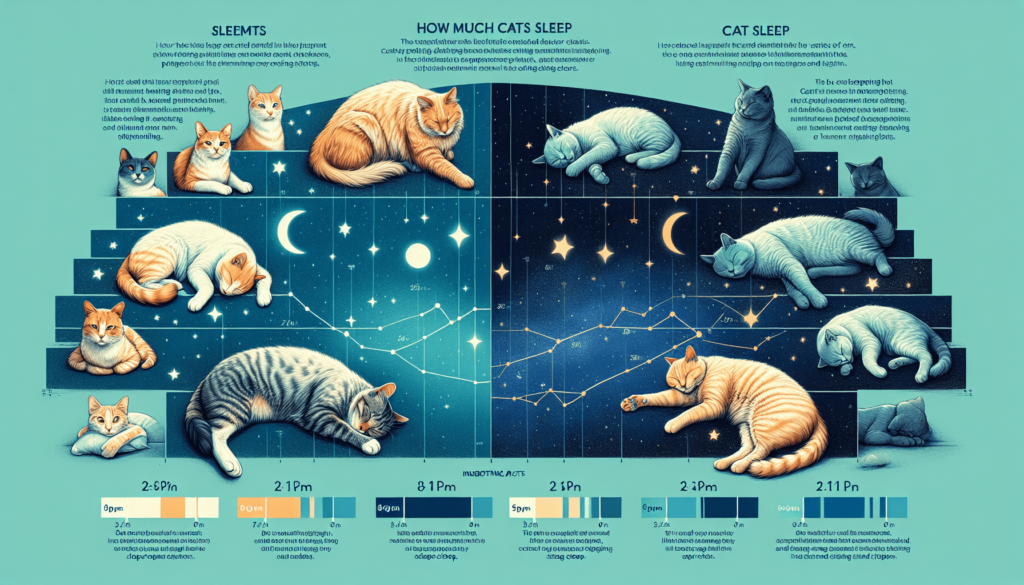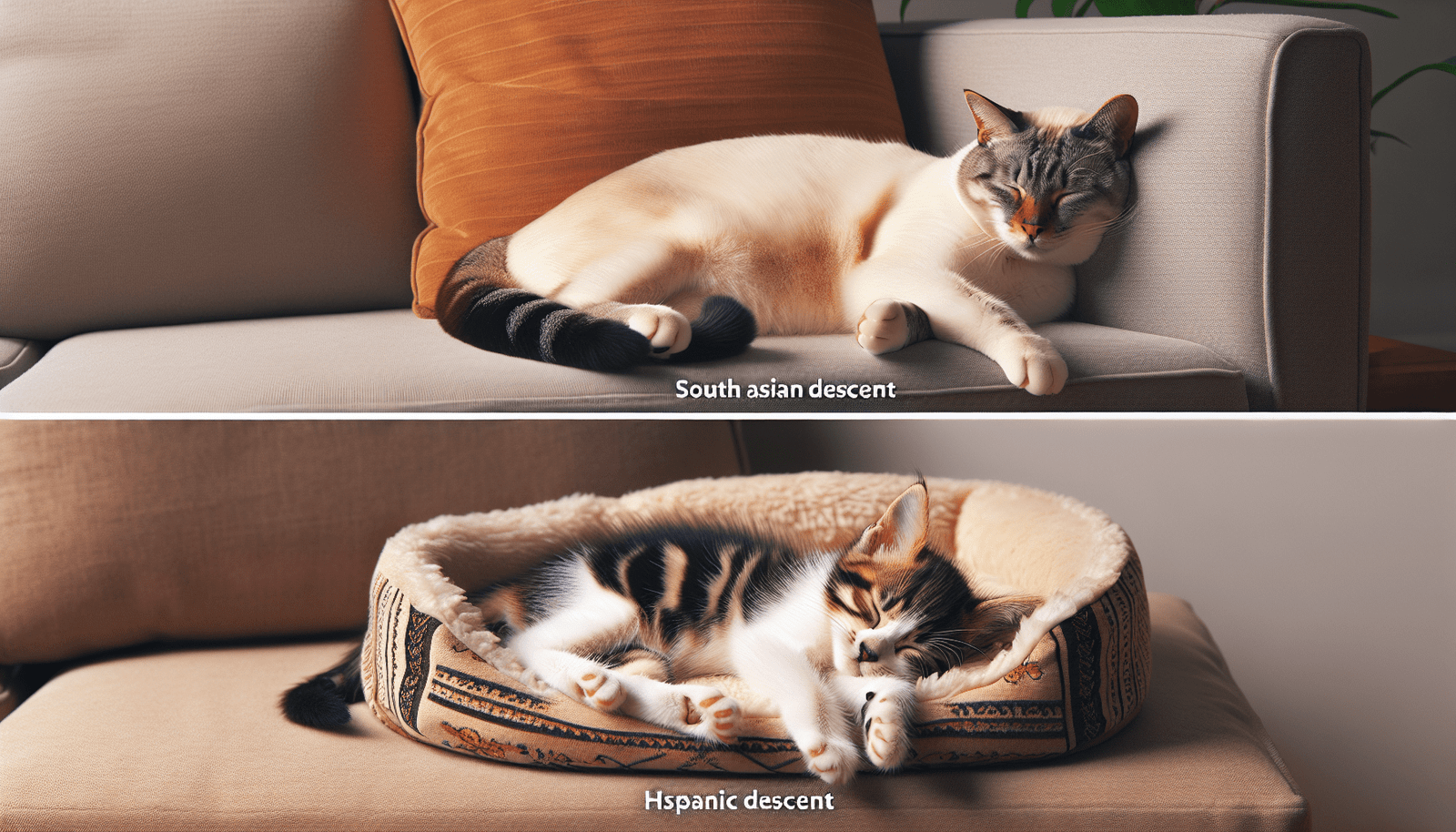Have you ever wondered how much cats sleep? It’s a common curiosity, considering their reputation for lazing around. Cats are known for their love of slumber, but just how many hours do they spend snoozing? In this article, we’ll explore the fascinating world of feline sleep patterns and uncover the surprising truths behind those long catnaps. Get ready to be whisked away into the realm of purrfectly serene slumber as we unravel the mystery of just how much our furry friends sleep.

Understanding Cat Sleep Habits
The sleep-wake cycle of cats
Cats are known for their unique sleep-wake cycle, which is quite different from humans. While humans have a monophasic sleep pattern, meaning that they sleep for a long period at night, cats have a polyphasic sleep pattern. This means that they sleep multiple times throughout the day and night, which adds up to a total of about 12 to 16 hours of sleep per day.
Significance of sleep for felines
Sleep is crucial for cats as it plays a vital role in their overall health and well-being. During sleep, cats can restore their energy levels, allowing them to be active and alert when awake. Sleep also aids in muscle repair, growth, and development. Additionally, sleep is essential for cognitive function and memory consolidation in cats.
Differences between cat sleep habits and human sleep habits
While cats and humans both need sleep, there are several key differences in their sleep habits. Cats have a shorter sleep cycle compared to humans, typically lasting 20-30 minutes. They also spend a significant portion of their sleep in REM (rapid eye movement) sleep, which is associated with dreaming. In contrast, humans have longer periods of REM sleep. Cats are also more adaptable when it comes to sleep, as they can adjust their sleep patterns based on their environment and external factors.
How Much Do Cats Sleep
Average sleep duration in a day for cats
On average, cats sleep for about 12 to 16 hours per day. However, this can vary based on their age, health, and individual needs. Kittens and senior cats tend to sleep more than adult cats, with kittens sleeping up to 20 hours a day. On the other hand, adult cats may sleep for around 12-16 hours.
Factors affecting a cat’s sleep duration
Several factors can influence the duration of a cat’s sleep. One of the primary factors is their level of activity. If a cat is engaged in stimulating activities, they may need less sleep. Additionally, the cat’s overall health, including any underlying medical conditions, can impact their sleep duration. Stress, changes in their environment, and the availability of comfortable sleeping spots can also affect a cat’s sleep patterns.
Analyzing variations in sleep patterns of kittens, adult cats, and senior cats
Kittens, being in the early stages of development, require more sleep than adult cats. This extended sleep period is necessary for their growth and development. Senior cats, on the other hand, tend to sleep more due to factors such as decreased activity levels and age-related changes in their body. Adult cats typically have a more balanced sleep pattern compared to kittens or senior cats.
Cat’s Sleeping Positions
Common sleeping positions of cats
Cats have a wide variety of sleeping positions, each unique and adorable in its own way. Some common sleeping positions include the “loaf” position, where the cat curls up into a compact ball, and the “stretched-out” position, where the cat lies on its side with all four legs extended. Other positions include the “donut” position, where the cat curls up with its tail wrapped around its body, and the “half-moon” position, where the cat lies on its back with its belly exposed.
What different sleeping positions can signify
A cat’s sleeping position can provide insight into its comfort level and mood. For example, a cat that sleeps in the “loaf” position is likely feeling relaxed and secure. On the other hand, a cat that sleeps with its belly exposed may be displaying trust and vulnerability. Paying attention to a cat’s sleeping position can help you understand their emotional state and provide appropriate care and attention.
The purpose of unique sleeping positions
Each sleeping position serves a purpose for cats. Cats often choose positions that allow them to conserve body heat effectively. Curling up into a ball helps retain body heat, especially during colder seasons. Stretching out allows the cat to cool down and regulate their body temperature. Additionally, some sleeping positions may provide cats with a sense of security and comfort, allowing them to relax and sleep more soundly.
Sleep Pattern Of Cats In Different Seasons
Impact of environmental factors on cat’s sleep
Environmental factors can significantly influence a cat’s sleep patterns, particularly in different seasons. In warmer seasons, cats may sleep less due to increased activity levels and the need to regulate body temperature. On the other hand, in colder seasons, cats may sleep more to conserve body heat and stay warm. Additionally, changes in natural lighting and daylight duration can also affect a cat’s sleep-wake cycle.
Sleep adjustments in cold and warm seasons
During colder seasons, cats may seek warmer spots to sleep, such as near heating vents or in cozy blankets. They may also curl up more tightly to conserve body heat. In contrast, during warmer seasons, cats may seek cooler areas to sleep, such as tile floors or shaded spots. They may also stretch out to dissipate body heat. Cats are excellent at adapting to different weather conditions to ensure their comfort during sleep.
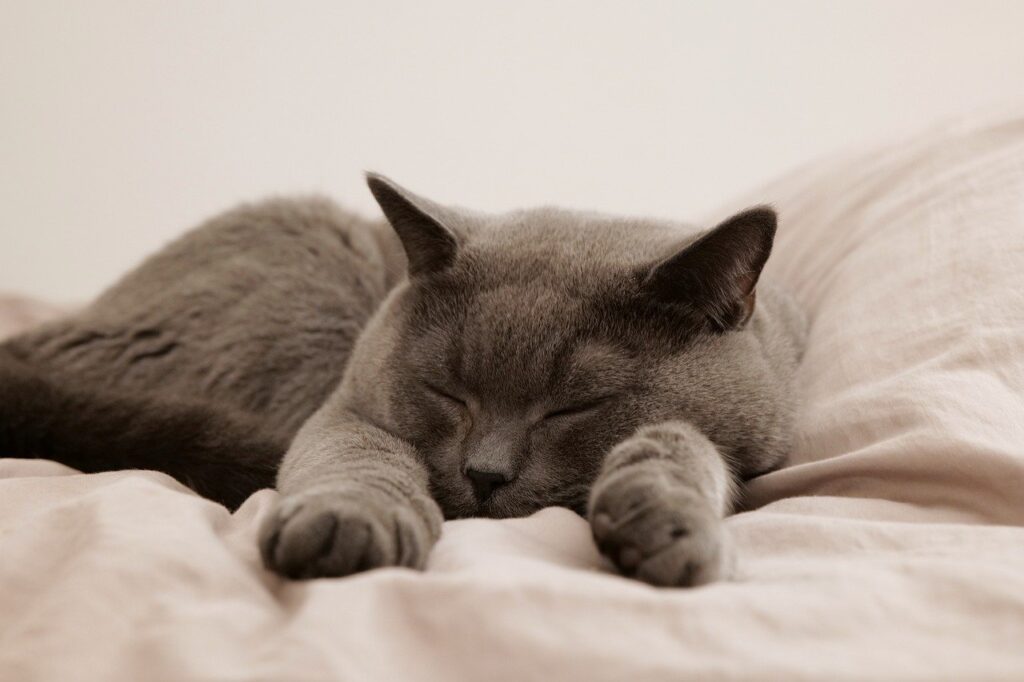
Sleeping Spots Preferred by Cats
Favorite sleeping locations of domestic cats
Cats have their preferences when it comes to sleeping spots. Some common favorite sleeping locations include sunny windowsills, soft beds or blankets, cozy nooks, and elevated perches. Cats also enjoy finding hidden spots, such as under furniture or in closets, where they can feel safe and secure.
How to create a comfortable sleeping spot for cats at home
To provide your cat with a comfortable sleeping spot at home, consider their preferences and needs. Provide soft and cozy bedding, such as blankets or cat beds, that caters to their comfort and warmth. Place their sleeping spot in a quiet and peaceful area, away from high-traffic zones. Make sure the sleeping spot is easily accessible yet offers privacy. Additionally, consider providing elevated perches or window beds so that your cat can enjoy a view while sleeping.
Understanding Cat Napping
What is cat napping and how often do cats nap
Cat napping refers to short periods of sleep that cats take throughout the day. Cats are skilled at dozing off and can take several naps lasting anywhere from a few minutes to a couple of hours. These brief naps help them recharge and conserve energy between their periods of more extended sleep.
Difference between a cat’s napping and night sleep
Cat napping serves a different purpose than their regular night sleep. While cats require longer periods of uninterrupted sleep during the night, their naps during the day help them stay alert and rested. These short bursts of sleep enable cats to be ready for any sudden activity or stimuli they encounter while awake.
Importance of napping for cats
Napping is essential for cats as it allows them to balance out their sleep-wake cycle, especially if they have a polyphasic sleep pattern. Naps help cats maintain their energy levels, promote better cognitive function, and contribute to their overall physical and mental well-being. Providing your cat with opportunities for regular napping can enhance their quality of life and help prevent exhaustion or fatigue.
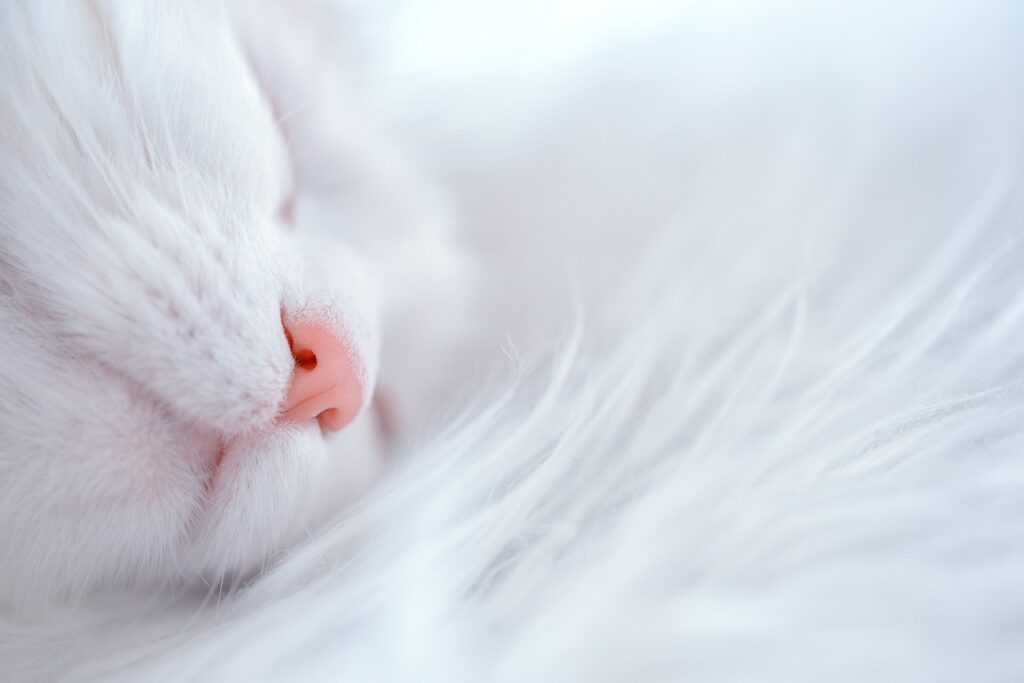
Significance of Dreams in Cats
Do cats dream during sleep
Yes, cats do dream during sleep, particularly during the REM (rapid eye movement) phase. Just like humans, cats experience different sleep stages, including REM sleep, which is associated with dreaming. During this phase, cats may twitch, move their paws, whiskers, or even make sounds as they react to their dreams. It is believed that cats dream about their daily experiences, such as hunting or playing.
Interpreting common behaviors seen in sleeping cats
Observing a sleeping cat can provide insights into what they may be dreaming about. If you notice your cat twitching or moving its paws rapidly, it could indicate that they are in the midst of an exciting dream, possibly chasing prey. On the other hand, if your cat’s whiskers or tail twitch, they may be dreaming about engaging with other cats or exploring their surroundings.
Impact of dreams on cat’s sleep quality
Dreaming is a natural part of a cat’s sleep cycle and is an essential component of their overall sleep quality. Dreaming allows cats to process their experiences and emotions, contributing to their mental and emotional well-being. Just like humans, cats need uninterrupted sleep, including dream-filled REM sleep, to ensure they wake up refreshed and ready for the day.
Abnormal Sleep Patterns in Cats
Identifying sleep disorders in cats
While it is normal for cats to have variations in their sleep patterns, certain abnormal sleep patterns may indicate an underlying sleep disorder. If you notice significant changes in your cat’s sleep routine, such as excessive sleep or sleeplessness, it is essential to monitor their behavior and consult a veterinarian if necessary. In some cases, sleep disorders in cats can be caused by medical conditions or external factors such as stress or environmental changes.
Analyzing causes of excessive sleep or sleeplessness
Excessive sleep or sleeplessness in cats can have various causes. Medical conditions such as thyroid imbalances, kidney disease, or pain can affect a cat’s sleep patterns. Stress, anxiety, or changes in their environment, such as a new home or the addition of a new pet, can also disrupt their sleep. It is crucial to identify the underlying cause to address the issue effectively and ensure your cat’s well-being.
Steps to take if a cat’s sleep pattern changes dramatically
If you notice significant changes in your cat’s sleep pattern, it is essential to take appropriate steps to address the issue. Start by observing your cat’s behavior and documenting any changes in their sleep routine. If the changes persist over a period of time or are accompanied by other concerning symptoms, schedule a visit to a veterinarian. They can conduct a thorough examination and recommend appropriate interventions or treatments based on the underlying cause.
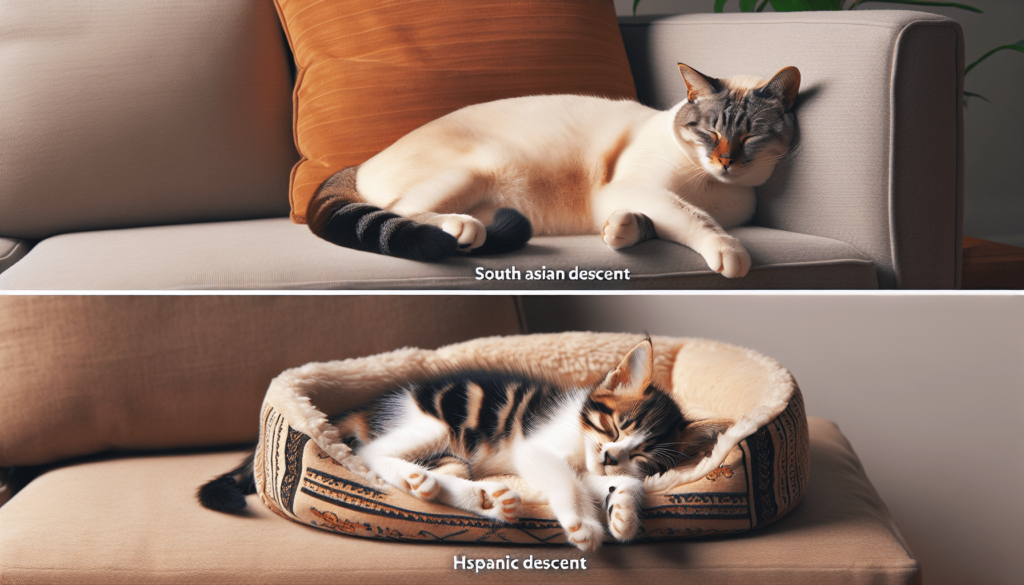
Influence of Diet on Cat’s Sleep
Impact of feeding schedule on cat’s sleep pattern
A cat’s feeding schedule can have an impact on their sleep pattern. Cats are crepuscular animals, meaning they are most active during dawn and dusk. By aligning their feeding schedule with their natural behavior, such as providing meals during these times, you can help regulate their sleep routine. Avoid feeding cats large meals right before bedtime, as it may disrupt their sleep due to discomfort or indigestion.
Types of food that can affect the quality of sleep in cats
The type of food cats consume can influence their sleep quality. Feeding cats a balanced and nutritious diet that meets their dietary needs can contribute to better sleep. High-quality cat food, rich in essential nutrients and protein, supports their overall health and well-being, including their sleep patterns. Avoid giving cats large amounts of treats or foods high in fat or carbohydrates close to bedtime, as it may lead to digestive issues or restlessness.
Understanding post-meal sleeping habits of cats
After a meal, cats often engage in a behavior known as “post-prandial somnolence,” which refers to the period of sleepiness or rest that follows a meal. This behavior is natural and serves as a way for cats to conserve energy and aid in digestion. It is common to see cats find a cozy spot to curl up and nap after a satisfying meal. Providing a comfortable sleeping spot nearby can enhance their post-meal relaxation and promote better digestion.
Ensuring a Good Sleep Environment for Cats
Importance of a safe, peaceful sleep environment
Creating a safe and peaceful sleep environment is crucial for cats to have quality rest. Cats are sensitive to their surroundings, and a calm environment can help minimize stress and anxiety, ensuring a comfortable sleep. Avoid loud noises, excessive light, or disruptive activities in the area where your cat sleeps to promote a peaceful sleep environment.
Tips and suggestions for improving sleep environment for cats
To enhance your cat’s sleep environment, consider the following tips:
- Provide a designated sleep area: Designate a specific spot or room for your cat to sleep, ensuring it is comfortable, quiet, and away from high-traffic areas.
- Create a cozy sleeping spot: Provide soft bedding, such as blankets or cat beds, that offer warmth and comfort.
- Minimize disruptions: Keep toys, food, and water bowls away from the sleeping area to prevent disturbances during sleep.
- Maintain an optimal temperature: Ensure the sleep area is at a comfortable temperature, neither too hot nor too cold, to support a good sleep environment.
- Consider white noise or calming scents: Some cats may benefit from soothing sounds or aromatherapy to create a relaxing atmosphere conducive to sleep.
Role of toys and play area in a cat’s sleep routine
Toys and play areas play an integral role in a cat’s sleep routine. Engaging in play and physical activity during wakeful periods helps cats expend excess energy, making it easier for them to relax and sleep better. Providing interactive toys, scratching posts, and climbing structures encourages cats to engage in play, which not only promotes better sleep but also contributes to their overall mental and physical stimulation.
In conclusion, understanding cat sleep habits is essential for ensuring the well-being of our feline friends. Cats have unique sleep patterns, sleep durations, and sleeping positions that are influenced by various factors. By creating a comfortable sleep environment, respecting their sleep needs and behaviors, and seeking professional help when necessary, we can help our cats achieve the optimal sleep quality they deserve. So next time you see your cat curled up in their favorite sleeping position, you’ll have a deeper appreciation for their fascinating sleep habits.
